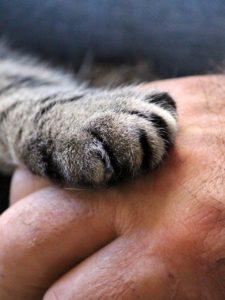Nail care is important. Keeping nails trimmed prevents nails from curling around and growing into the toe pad. Long nails are more likely to snag on things and break. Cats with excessively long nails will walk differently and joints in the feet may become stressed. Keeping the nails trimmed will also decrease the destructiveness of scratching things and is a superior alternative to declawing (surgical amputation at the last knuckle of each toe).

Cat nails are generally clear or mostly clear. They have a long-tapered point. Trimming the very sharp point off is safe and will avoid hitting the blood supply and nerve endings. Adult cat nails will often be tucked up in the toe. They can be more easily seen by applying gentle pressure to the top of the toe and the toe pad. Avoid cutting very close to the pink quick. The black line in the picture shows a safe location to cut this nail. Taking a little off with each clip will help you stop before you cut too far.

Cats and kittens can be taught to enjoy handling and nail care. Having a designated location for training is a good way to build a positive association with nail trimming and handling. Kittens can often be taught to eat canned food out of a syringe or squeeze pouch while lying in your lap on their backs. Adult cats are often more comfortable in an upright seated or laying position. Go with a start position that is comfortable for you and your cat.
The first step is to teach your cat that the training location equals treats. The next step is to teach your cat that touch from the human predicts food. Clicker training is a great way to help cats learn these associations quickly. Clicker training also often will help your cat learn what needs to be done to earn the treat. Cats have short attention spans and benefit from frequent breaks.
Try to keep in mind that the main goal while working with your cat on any skill, especially handling skills, is for your cat to enjoy the experience. Keeping your focus on your cat’s enjoyment will help prevent getting too wrapped up in just getting the nail trim finished now.
Here is a video demonstration of nail trim training . If you are unfamiliar with clicker training or need some help getting started email beth@rwanimalbehavior.com.
